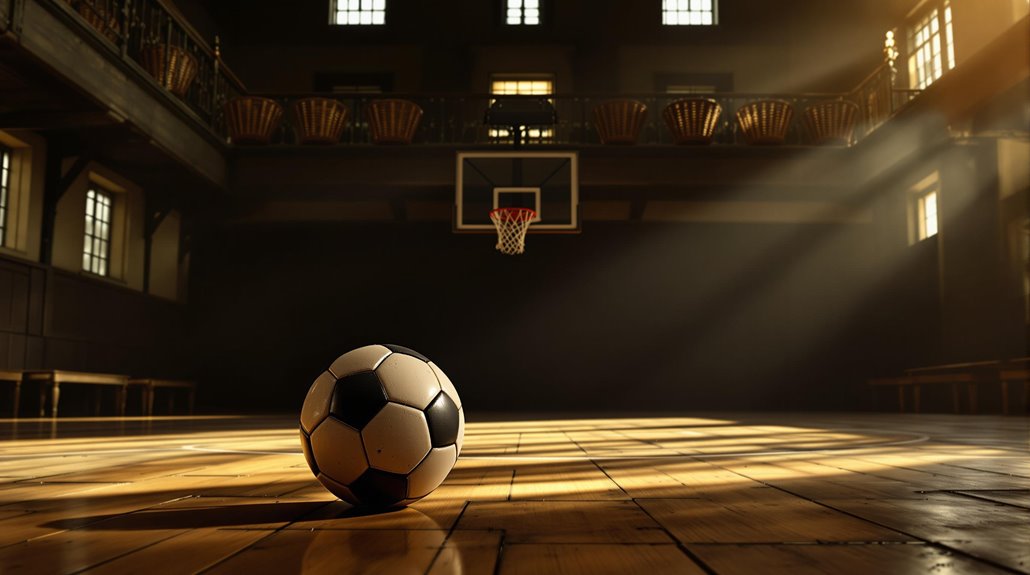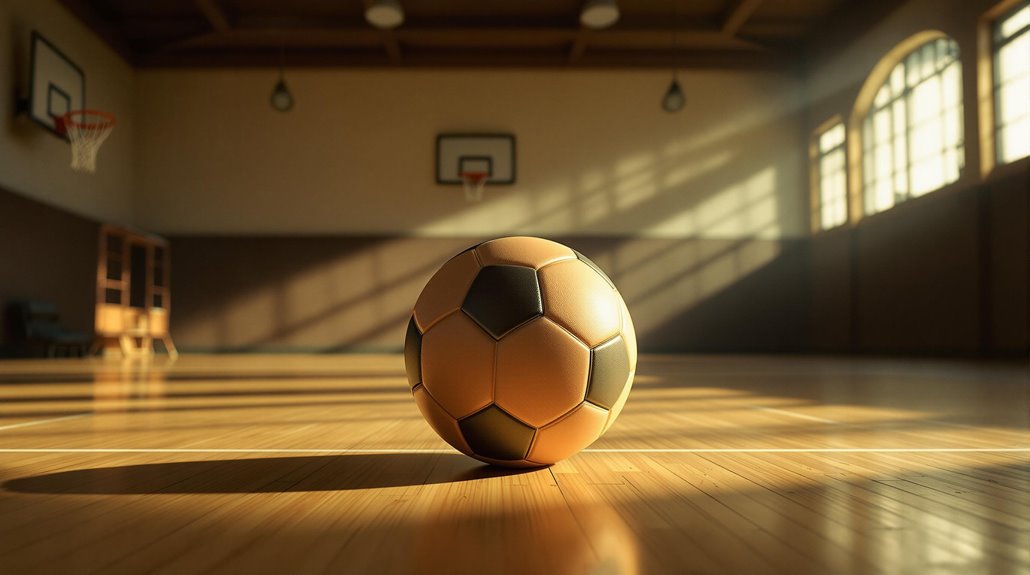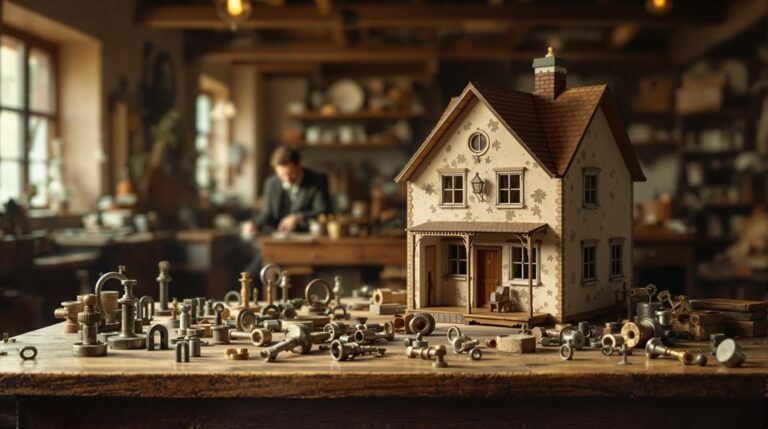Basketball Was First Played Using a Soccer Ball
You might be surprised to learn that basketball's first players couldn't simply walk into a sporting goods store to buy proper equipment. When Dr. James Naismith created the game in 1891, he had to work with what was available at the YMCA Training School. That's why he grabbed a soccer ball from the equipment room for the very first game. This practical decision, made out of necessity, would influence how the sport developed and how players adapted their techniques.
The Birth of Basketball and Its Early Equipment
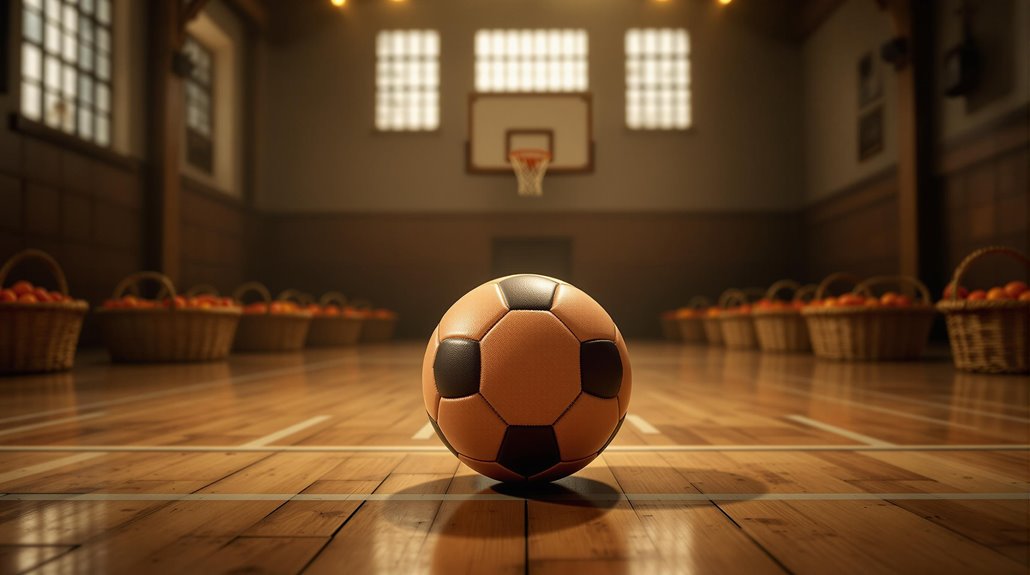
When James Naismith invented basketball in December 1891, he couldn't have imagined how his simple winter activity would transform into a global phenomenon.
At the YMCA Training School in Springfield, Massachusetts, he crafted 13 basic rules and set up an innovative indoor game using equipment that was readily available – a soccer ball and two peach baskets mounted 10 feet high on opposite ends of the gymnasium.
If you'd explored early basketball history, you'd find the game quite different from today's version. Early games experimented with teams of fifty players on the court at once.
Players had to manually retrieve the ball after each score since the peach baskets retained their closed bottoms.
The early game evolved quickly, though, with cast iron rims replacing baskets by 1893, and Spalding introducing the first official basketball in 1894, weighing less than 20 ounces. Later improvements included transitioning from traditional designs to an enhanced version with eight panels in 1970.
Why Soccer Balls Were the Original Choice
Have you ever wondered why Naismith chose a soccer ball for his newly invented game? The historical significance of this decision stems from practical considerations in 1891.
Soccer balls were readily available at physical education facilities, and students already knew how to handle them, making equipment accessibility a non-issue.
These leather balls, with their inflatable bladders, provided the perfect combination of size, weight, and durability for indoor play. However, the laces on soccer balls caused some problems when used on hard basketball courts. Dr. James Naismith created the game to keep students active during cold winter months.
You'll find it interesting that the sports equipment industry hadn't yet developed specialized balls, so creating a new type would've been time-consuming and costly.
The soccer ball's versatility proved ideal – you could throw, catch, and pass it effectively. Its spherical shape and bounce characteristics enabled various playing techniques, making it a natural choice for basketball's early development.
Challenges of Playing With Laced Balls
The laced basketball presented numerous challenges that modern players would find almost unimaginable. You'd struggle with basic dribbling challenges as the laces created unpredictable bounces, making it difficult to maintain control during fast-paced play.
The ball's irregular movement would limit your ability to execute various dribbling techniques and increase your chances of turnovers. Today's players wearing dizzy goggles would have found it nearly impossible to control these old laced balls.
The shooting difficulties were equally frustrating. You couldn't rely on consistent ball grip or spin control, which considerably affected your shooting accuracy. These challenges were especially apparent during the game's early days when soccer balls were used because proper basketballs didn't exist yet.
The laces would interfere with your shot trajectory and make it harder to develop proper muscle memory.
When passing, you'd face problems with accuracy and ball handling, especially during quick plays.
There were also safety concerns, as the laces could cause finger injuries and make catching high-speed passes more dangerous.
Evolution From Soccer Ball to Modern Basketball
Back in 1891, James Naismith's invention of basketball relied on readily available soccer balls and peach baskets as makeshift equipment.
You'll find it interesting that the game evolution progressed rapidly from these humble beginnings, as soccer balls with laces proved problematic on hard courts.
The first major advancement in ball design came in 1894 when Spalding manufactured the first standardized basketball.
By 1929, you'd see basketballs with concealed laces and better bounce characteristics.
The 1940s brought molded basketballs that maintained their shape, while the 1970s introduced an 8-panel design for enhanced grip.
Today's basketballs feature synthetic materials and precise specifications, with different sizes for men's and women's games.
The original brown leather has given way to orange coloring, making the ball more visible during play.
Since these early designs used peach baskets, players had to manually retrieve the ball after each successful shot.
Legacy of Early Basketball Equipment
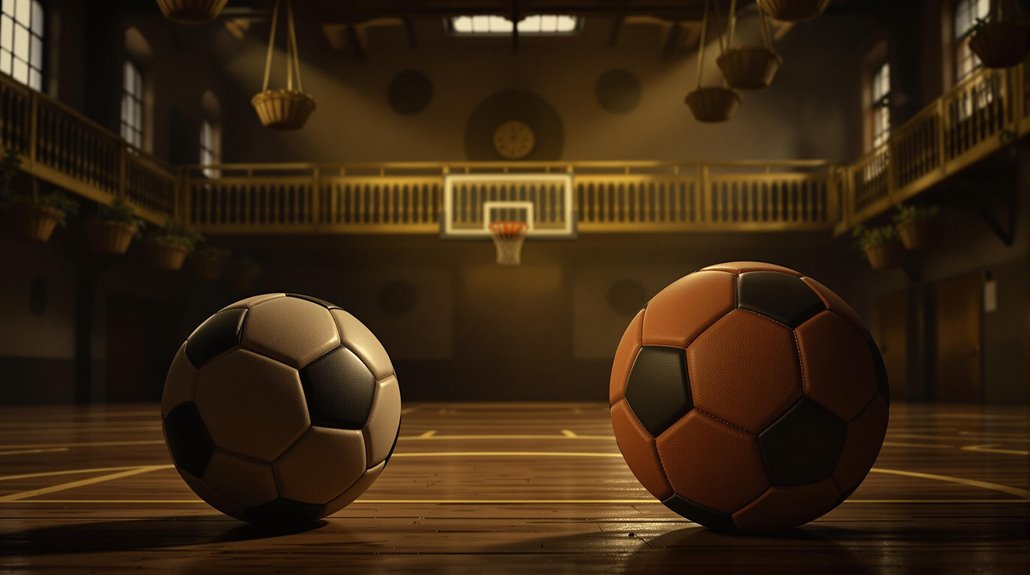
Original basketball equipment left an indelible mark on the sport's development and cultural identity.
You'll find the equipment symbolism in basketball's earliest tools – from peach baskets to soccer balls – showcasing how innovation emerged from simple resources. These rudimentary items sparked grassroots innovation that shaped the game's evolution.
You can trace modern basketball's DNA to these humble beginnings. The progression from peach baskets to open nets revolutionized scoring, while the shift from laced to laceless balls improved player control. Dr. James Naismith created the game with thirteen basic rules that continue to influence modern basketball equipment design.
Today, you'll discover this legacy preserved in museums and historical reenactments, where vintage equipment tells the story of basketball's transformation. The DIY spirit of early basketball equipment continues to inspire, reminding us how resourcefulness and necessity drove the sport's remarkable evolution.

